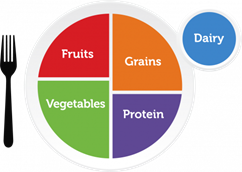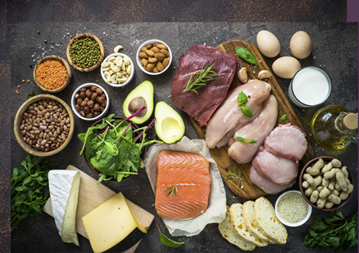MyPlate is a guide published by the USDA to help the community members plan and create nutritious meals. MyPlate incorporates food from all five food groups: fruits, vegetables, grains, proteins, and dairy.
Proteins are an important part of the diet. Protein consumption is especially important during periods of growth and development in children and teens. 1 From protein, we get the energy that we need to build and maintain bones, muscles, and skin.
Eating a lot of different proteins is important in your child’s diet as it ensures that they are getting the full range of vitamins and minerals that help their body to function and perform well. Nutrients provided by protein include B-vitamins (ex. niacin, thiamin, and riboflavin) along with vitamin E, iron, zinc, and magnesium. 1 B vitamins help with muscle development, magnesium helps to build strong bones, and zinc supports a healthy immune system. EPA and DHA are omega-3 fatty acids found in seafood and are also essential for brain development.
Proteins can come from meats, poultry, and seafood, but they can also come from a plant source. A common misunderstanding about protein is that it must come from meat. However, proteins from plants can be just as nutritious and satisfying when paired with other foods. Examples of plant-based protein include nuts, seeds, beans, peas, lentils, and soy products. 1 Remember to be mindful when choosing your protein source.
An example of 1-oz protein or protein equivalent could be 1 egg, ¼ cup of cooked beans, or even 1 tablespoon of almond or peanut butter.
The recommended servings for protein, by age group 1
| Daily Recommendation in Ounce-Equivalents (oz-equiv) | |
| Toddlers (12-23 months) | 2 oz-equiv |
| Preschool (2-4 yrs.) | 2 to 5 oz-equiv |
| Childhood (5-8 yrs.) | 3 to 5 ½ oz-equiv |
| Pre-Teens (9-13 yrs.) | 4 to 6 ½ oz-equiv |
| Teenagers (14-18 yrs.) | 5 to 7 oz-equiv |
Many children may prefer other food groups over protein, and it may be hard to introduce new protein sources to a picky eater. When introducing new food items, they should be paired with ones that your child already likes eating on a regular basis. This is so that they are more accepting of the new food item. It is normal if your child does not like the new food item at first. Encourage them to try new things, but do not force them to eat them if they do not want to. This can cause them to form an unhealthy relationship with food. New food experiences should be positive. It can take multiple introductions of a new food item for the child to start liking it. 2
What new protein item would you add to your meals?
By Helen Abdullah-Nguyen, University of Texas Health Science Center Dietetic Intern
References
- Protein Foods. MyPlate. Accessed April 6, 2022.
- Picky Eaters and What to Do. Nutrition. Published December 17, 2020. Accessed April 6, 2022.


